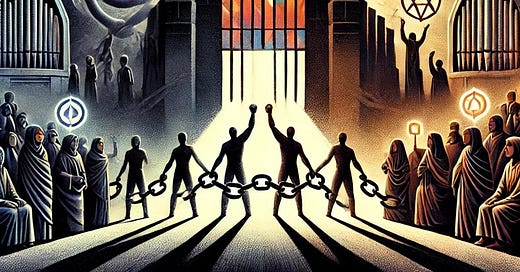Constructing Whiteness: Christianity's Shadow
Exploring how faith was weaponized to create racial hierarchies and uphold systems of oppression—and what it takes to dismantle them.
Introduction: Constructing Whiteness: Christianity and Racial Hierarchies
How does a theological framework born from love and liberation become a justification for racial supremacy? This question takes us to the heart of one of Christianity's most devastating legacies: the construction of whiteness.
In this series, “I Want to Wish You an Eschatological Christmas,” we’ve traced the historical arc of Christianity, exploring how it evolved from a marginalized faith to a cornerstone of empire, used to justify colonization, capitalism, and class stratification. Now, we turn to one of its most insidious transformations—the sanctification of racial hierarchies.
Whiteness, as a social construct, was not inevitable. It was built, justified, and maintained through theology, colonial practices, and systemic violence. Christian narratives of "civilized vs. savage" sanctified antisemitism, Islamophobia, and anti-Blackness, weaving a web of oppression that still defines global systems today.
This article unpacks how Christianity helped construct racial hierarchies, how these constructs are tied to supremacy culture, and what it means to confront and dismantle whiteness. Together, we’ll explore the intersections of power, privilege, and transformation, asking: How can we unmake what was so carefully built to divide us?
Christianity’s First Victims: White Bodies in Europe
Before Christianity expanded its reach to colonize Black, Indigenous, and other non-European peoples, it first solidified its power by controlling white-bodied Europeans. The same systems of domination, violence, and suppression that were later exported to justify colonialism were perfected within Europe itself.
How Christianity Violated White Europeans
Feudalism: The Church reinforced feudal hierarchies, stripping peasants of land and autonomy while concentrating wealth in the hands of the clergy and aristocracy.
Witch Hunts: Tens of thousands of women, particularly healers and midwives, were persecuted and executed under the guise of rooting out heresy. This severed communities from ancestral knowledge and instilled a fear of dissent.
The Enclosure Movement: Communal lands were privatized, displacing peasants and creating cycles of poverty. The Church supported these policies, often benefiting financially from the process.
Why This Matters to Whiteness
White-bodied Europeans were some of the first to experience the systems of control that would later be used to marginalize non-white peoples. Recognizing this history is critical for white readers: the system of whiteness does not serve you—it manipulates you to maintain supremacy culture while severing you from your own ancestral roots, humanity, and connection to others.
Reflection Question: How does recognizing Christianity’s early harm to white Europeans change your understanding of how supremacy culture operates?
Theological Roots of Racial Hierarchies
The construction of whiteness is deeply tied to Christianity’s role in empire-building. As European powers expanded their reach, they needed a framework to justify their domination over non-European peoples. Christian theology provided that framework, creating a racialized hierarchy that defined Europeans as “civilized” and everyone else as “savage.”
Civilized vs. Savage: The Religious Binary
At the heart of this racial hierarchy was a theological binary:
Civilized: Associated with whiteness, Christianity, and European culture. This identity was framed as morally superior, chosen by God to lead, convert, and dominate.
Savage: Attributed to Black, Indigenous, and other non-European peoples, whose cultures, religions, and identities were labeled as heathen or demonic.
Key theological narratives reinforced these binaries:
The Curse of Ham (Genesis 9:20-27): This biblical story was interpreted as a justification for slavery and racial hierarchy, framing Blackness as a curse and servitude as divinely ordained.
The Great Commission (Matthew 28:19): The call to "make disciples of all nations" was weaponized to legitimize colonial conquest, framing the forced conversion of Indigenous peoples as a moral duty.
The Promised Land (Exodus 3:17): The narrative of divine land entitlement was used to justify displacement and genocide, from the colonization of the Americas to the apartheid policies in South Africa.
The Role of Supremacy Culture in Constructing Whiteness
Supremacy culture didn’t just rely on overt violence; it built systems of thought that normalized whiteness as the standard and made racialized oppression invisible. Here’s how these pillars of supremacy culture intersected with Christian theology to create and sustain racial hierarchies:
Individualism and the Right to Comfort
Individualism: Supremacy culture elevated individual achievement, aligning it with whiteness and the Protestant ethic of personal responsibility. This narrative erased the structural barriers faced by racialized groups, framing poverty and oppression as personal failures rather than systemic issues.
Right to Comfort: Whiteness was constructed as the default, centering white experiences and framing discomfort (e.g., confronting racism) as a violation of inherent rights. Christian theology sanctified this by equating whiteness with morality, making the discomfort of others (e.g., Indigenous displacement or Black suffering) morally permissible.
Supremacy Culture and the Weight of This Work
This work is heavy. Confronting centuries of lies and misleading education requires not only intellectual engagement but also emotional endurance. We have all been indoctrinated into systems of supremacy—systems that thrive on division, silence, and denial.
Acknowledging the Weight
It’s important to recognize that this process is not light work:
Emotional Toll: Unlearning internalized biases and confronting historical harm can feel overwhelming.
Systemic Resistance: The systems we are working to dismantle are deeply entrenched, making progress slow and difficult.
Centering Rest and Joy
This is why rest and joy are imperative. Liberation is not just about dismantling systems; it’s about embodying the world we want to create. Taking moments to pause, reflect, and celebrate small joys is an act of resistance in itself.
Reflection Question: What practices can you cultivate to sustain yourself in the work of confronting whiteness and supremacy culture?




